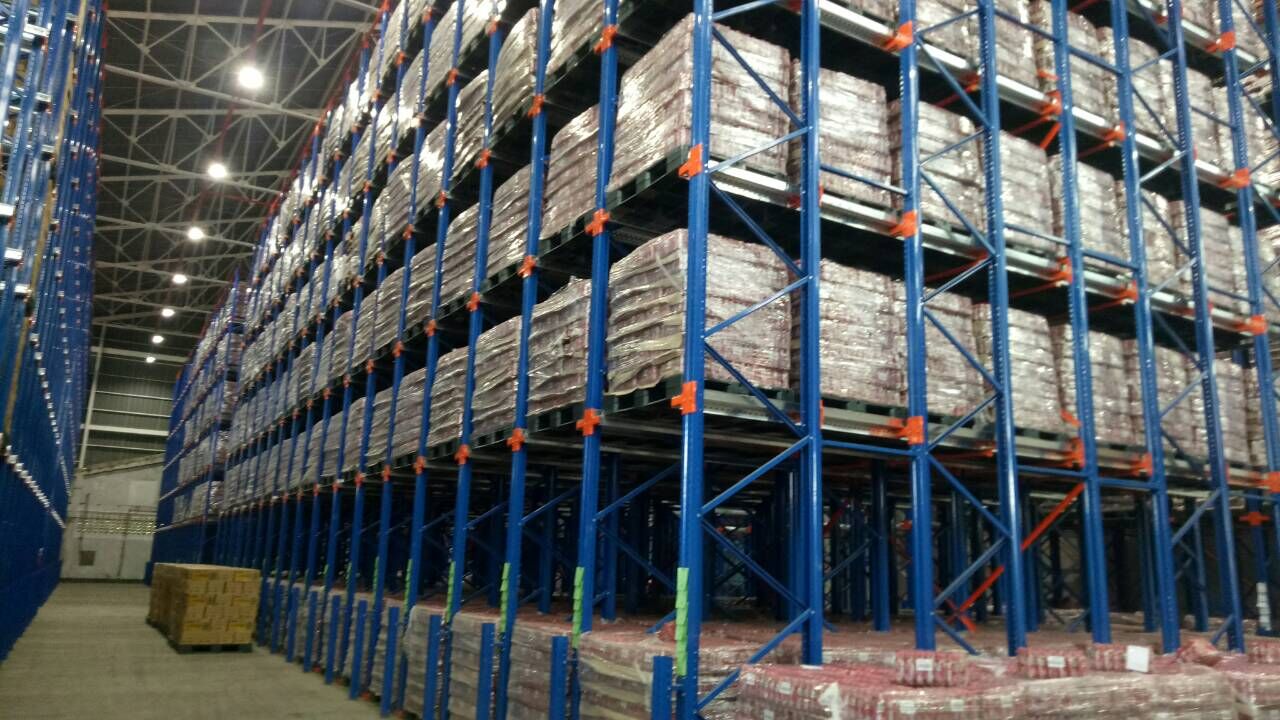倉庫効率を徹底的に追求する上で、保管密度の最大化は不可欠です。セレクティブパレットラックはアクセス性を高めますが、同一SKUの大量保管が主なニーズだとしたらどうでしょうか?高密度保管の原動力、ドライブインラックシステムの登場です。そのコア構造を詳しく分析し、スペース活用と業務フローにどのような革命をもたらすのかを探ってみましょう。

1. コア構造:通路ではなく奥行きを重視した設計
通路の多い従来のラックとは異なり、ドライブイン ラックは独自の構造設計によって定義されます。
連続レール:これが特徴的な構造です。各階層に個別の梁を設置する代わりに、各保管階層のベイの奥行き全体にわたって、長く連続した荷重レールが敷設されています。これらのレールは、堅牢な垂直フレームによって支えられています。
垂直フレーム:高耐久性の柱が垂直のバックボーンを形成し、必要なベイ幅と積載容量に応じて間隔が空けられています。フォークリフトの進入時に発生する大きな荷重と力に耐えられるよう、特別に設計されたブレースが採用されています。
ガイドレールと入口ガイド:安全性と誘導性を確保するために不可欠です。床面に設置された頑丈なレールが、フォークリフトのタイヤを正しいレーンに誘導します。前面の入口ガイドは、支柱を衝撃から保護し、スムーズな入退出を実現します。
構造ブレース: 強力な斜めおよび水平ブレースにより、大きな荷重を支え、構造内で作動するフォークリフトの動的な力に耐えるために不可欠な、優れた安定性が実現します。
奥行き構成:ベイは通常非常に深く、各保管階のレーンごとに5枚、7枚、あるいはそれ以上のパレットを収納できる場合が多くあります。構造全体がフォークリフトのための「トンネル」を形成します。
2. 空間の最適化:密度が最優先
ドライブイン ラックは、倉庫のレイアウトを根本的に変えることで、比類のない保管密度を実現します。
最小限の通路:これが最大の省スペース化の要因です。複数の保管レーン(奥行き方向)ごとに必要なアクセス通路は1つだけです。フォークリフトはレーンに直接乗り入れ、パレットの出し入れを行います。これにより、セレクティブラック方式と比較して、通路に無駄な床面積が大幅に削減されます。
ベイの高利用率: 倉庫の高さの容積全体を活用し、レーンあたりの奥行きを最大化することで、ドライブイン システムは、選択的ラックと比較して、同じ設置面積内で保管容量を 50 ~ 75% 以上増やすことができます。
深いレーン保管: 各レーンの奥深くにパレットを保管できるため、アクセスできなかったり、非効率的に使用されていた倉庫スペースを活用できます。
3. 効率性の向上:大量生産SKUの合理化
個々のパレットへのアクセスは瞬時ではありませんが、ドライブイン ラックは特定の操作に大きな効率上の利点をもたらします。
少数SKUで高スループット:限られたSKUを大量に保管するのに最適です。レーン全体を一括して積み込み・積み下ろしすることで、バルク貨物の取り扱いが非常に効率的になります。
FIFO または LIFO の柔軟性: 製品要件に応じて、先入先出法 (FIFO - 入口側と出口側が必要) または後入先出法 (LIFO - 入口側と出口側が単一) の在庫管理に設定できます。
移動時間の短縮 (レーン内): レーン内に入ると、フォークリフトは狭い通路で操作する必要なく、連続したレールに沿って比較的速くパレットを置いたり取り出したりすることができます。
バルクハンドリングに最適化: 季節商品、原材料、または大量の同一品目を密集して保管する必要がある完成品に最適です。
実装に関する重要な考慮事項:
フォークリフトオペレーターのスキル: ラック構造内の限られたスペースでの操作に慣れた熟練オペレーターが必要です。
荷物の均一性: 寸法と重量が同一の均一で安定したパレット荷物の場合に最適です。
スループット vs. アクセス性:密度を高めるため、各パレットへの直接アクセスは犠牲になります。回転率の低い商品やバッチピッキングに最適です。
構造的完全性: 動的負荷条件下での安全性を確保するために、設計と設置はエンジニアリング標準 (RMI MI MH16.1 など) に厳密に準拠する必要があります。
結論:密度のチャンピオン
ドライブインラックは万能なソリューションではありませんが、均質な製品を高密度に保管することが主な目的である場合、そのコア構造は比類のない省スペースを実現するように設計されています。通路を最小限に抑え、奥行きを最大限に確保することで、倉庫レイアウトを変革し、既存の壁面内でより多くの商品を保管できるようになります。大量在庫のSKUでスペースの制約に悩まされている場合、ドライブインラックは倉庫の真の保管能力を引き出す鍵となるかもしれません。
ドライブインラックが貴社の業務に最適な高密度ソリューションかどうか、ぜひご検討ください。ご相談はお気軽にお問い合わせください。
ダフネ・ワン
2025年11月28日

Add: NO.409 West Jianshe Road, Economic Development Zone, Jinhu County, Jiangsu Province, China
著作権
2025@ Jiangsu Kingmore Storage Equipment Manufacturing Co., Ltd 全著作権所有。
サイトマップ
| ブログ
| Xml
| プライバシーポリシー
 サポートされているネットワーク
サポートされているネットワーク